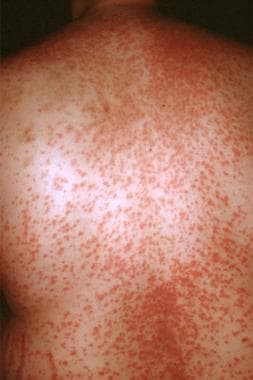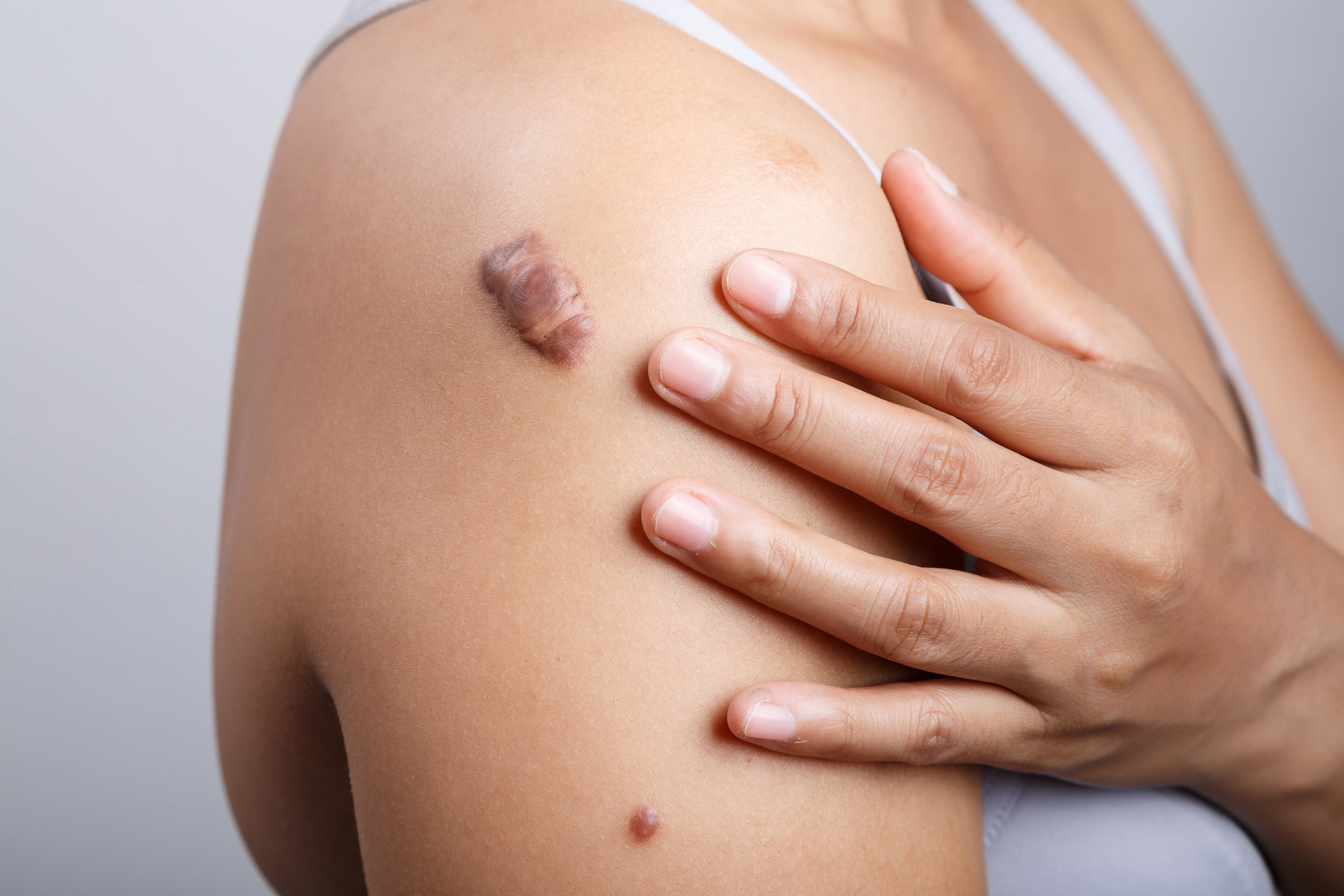Definisi
Erupsi obat adalah reaksi kulit terhadap obat. Dua tipe erupsi obat yang akan dibahas disini adalah exanthematous drug eruption (EDE) dan fixed drug eruption (FDE).
- Exanthematous Drug Eruption (EDE)
Erupsi obat morbiliformis adalah reaksi kulit akibat obat yang paling sering terjadi di antara tipe erupsi obat lainnya. EDE diperkirakan terjadi pada 95% dari kasus erupsi obat. Reaksi kulit masih bisa muncul walaupun konsumsi obat penyebab sudah dihentikan.
- Fixed Drug Eruption (FDE)
Tipe erupsi obat yang khas, di mana gejala timbul atau kambuhnya ruam berada di lokasi tubuh yang sama saat terkena paparan ulang terhadap obat penyebab. Fixed drug eruption lebih jarang dibandingkan dengan EDE, namun tetap menempati urutan kedua atau ketiga dari reaksi kulit terhadap obat yang paling sering terjadi. Paparan obat yang berulang bisa menyebabkan munculnya ruam kulit baru.
Rata-rata ada sekitar 2% resep obat baru yang menimbulkan erupsi obat pada pasien. Namun, perlu diketahui bahwa beberapa gejala kadang salah dianggap terjadi karena obat.
Penyebab
Terdapat beberapa penyebab timbulnya reaksi kulit akibat obat, yaitu:
- Alergi yang terjadi karena reaksi kekebalan tubuh. Terdapat dua jenis reaksi alergi yang dimediasi oleh antibodi dan sel imun yang berbeda, yaitu:
- Reaksi alergi langsung yang terjadi dalam satu jam setelah Anda terpapar dengan obat penyebab.
- Reaksi alergi tertunda, terjadi dalam rentang 6 jam sampai beberapa minggu setelah paparan pertama dengan obat.
- Efek samping yang bisa timbul dari pemakaian obat.
- Intoleransi obat (misalnya reaksi terkait dosis obat).
Contoh Obat Penyebab
Beberapa obat seperti antibiotik dan obat antiepilepsi lebih sering menyebabkan erupsi obat dibandingkan dengan golongan obat lain, seperti misalnya obat-obatan jantung.
Exanthematous drug eruption (EDE) paling sering terjadi setelah penggunaan:
- Antibiotik penisilin dan golongan sulfa.
- Antikejang fenitoin.
- Antipsikotik klorpromazin.
- Antihipertensi kaptopril.
- Obat-obatan lain, seperti allopurinol, naproksen, piroksikan, penisilamin-d, dll.
- Obat kemoterapi dan imunoterapi.
Sementara itu, juga banyak obat yang bisa menyebabkan fixed drug eruption (FDE). Frekuensi obat dalam menimbulkan FDE bervariasi pada setiap negara tergantung ketersediaan obat serta tingkat pemakaian obat tersebut. FDE paling sering dikaitkan dengan obat-obatan berikut:
- Antibiotik, seperti penisilin, trimethroprim-sulfametoksazol, tetrasiklin, kuinolon, atau dapson.
- Antikejang seperti barbiturat, karbamazepin.
- Obat Antiinflamasi nonsteroid (OAINS) seperti ibuprofen, naproksen, asam mefenamat.
- Asetaminofen atau parasetamol.
- Antimalaria seperti kuinin.
- Sildenafil sebagai salah satu obat untuk mengatasi gangguan ereksi.
- Antipsikotik fenotiazin.
Faktor Risiko
Rata-rata, sekitar 20% peresepan obat baru akan menyebabkan erupsi obat. Faktor risiko terjadinya erupsi obat adalah:
- Jenis kelamin perempuan, umumnya reaksi alergi akibat beberapa obat-obatan sedikit lebih sering ditemukan pada wanita dibandingkan pria.
- Terdapat faktor genetik yang bisa membuat seseorang lebih rentan mengalami erupsi obat, mungkin saja ada perbedaan dalam metabolisme obat pada dirinya, contohnya bisa membuat mereka lebih mudah mengalami intoleransi obat.
- Fixed drug eruption (FDE) ditemukan pada pasien dari usia 1,5 tahun hingga 87 tahun, dengan rata-rata usia 30-31 tahun.
- Infeksi virus atau penyakit tertentu dapat memengaruhi reaksi tubuh terhadap obat.
- Riwayat reaksi alergi atau intoleransi terhadap obat bisa meningkatkan risiko terjadinya erupsi obat.
- Semakin banyak obat yang diresepkan, akan semakin tinggi kemungkinan alergi yang bisa terjadi.
Gejala
Gejala Exanthematous Drug Eruption (EDE)
Gejala EDE adalah ruam berupa bercak atau bintik-bintik merah pada kulit yang sering muncul pada punggung dan menyebar secara simetris pada torso dan kedua lengan. Pada kasus yang berat, ruam-ruam ini dapat menyatu dan menyebabkan eritroderma (kondisi kemerahan dan pengelupasan kulit pada >90% area tubuh).
Telapak tangan, telapak kaki, dan selaput lendir juga dapat terkena. Gatal adalah keluhan yang umum terjadi. Demam bisa timbul pada reaksi obat yang berat. Ruam dan bercak kulit biasanya timbul dalam 7-10 hari hingga 14 hari setelah memulai pengobatan. Reaksi obat bisa tetap terjadi bahkan setelah obat sudah dihentikan.
Gejala Fixed Drug Eruption (FDE)
FDE biasanya menimbulkan gejala adanya bercak bulat atau oval yang berbatas tegas, dengan warna merah kehitaman sampai coklat atau hitam. Bercak ini bisa berubah menjadi plak yang dapat disertai atau tidak disertai oleh gelembung berisi cairan. Keluhan kulit bisa muncul di area manapun di tubuh, seperti bibir, area kelamin dan anus, tangan atan kaki. Lokasi lainnya yang juga sering terkena adalah pinggul, punggung belakang, atau anggota gerak atas.
Keluhan kulit bisa disertai rasa gatal, sensasi terbakar atau tersengat. Umumnya pasien tidak mengeluhkan gejala seperti demam dan rasa tidak enak badan. Pada area mulut atau kelamin bisa timbul juga tukak.
Pada FDE, gejala dapat muncul sekitar 30 menit sampai 8 jam pasca konsumsi obat, walaupun keluhan kulit juga bisa muncul setelah 2 minggu pasca paparan obat. Gejala dapat menetap sampai beberapa minggu lalu menghilang secara perlahan dan meninggalkan bercak gelap.
Paparan berulang terhadap obat pencetus dapat menyebabkan timbulnya keluhan kulit baru dan aktifnya bercak lama yang sudah ada. Peradangan kulit bisa terjadi dalam kurun waktu 30 menit sampai 16 jam setelah paparan.
Diagnosis
Untuk mendiagnosis erupsi obat dan menentukan tingkat keparahannya, dokter akan bertanya mengenai riwayat kesehatan dan gejala yang Anda alami, serta melakukan pemeriksaan fisik secara umum. Informasikan riwayat pengobatan Anda secara detail meliputi seluruh jenis obat yang Anda konsumsi serta cara pengobatannya, apakah obat diminum atau disuntikkan. Dokter juga akan menanyakan bila Anda pernah mengalami hal yang sama sebelumnya.
Erupsi obat ringan biasanya dapat didiagnosis dengan pemeriksaan fisik saja. Terkadang sulit untuk menentukan obat mana yang menyebabkan timbulnya reaksi pada kulit. Pada erupsi yang berat atau menetap, pemeriksaan lebih lanjut mungkin dapat dibutuhkan. Pemeriksaan penunjang yang bisa dilakukan umumnya adalah:
- Uji cukil kulit (skin prick test), pemeriksaan ini dapat dilakukan untuk memeriksa adanya reaksi langsung terhadap antibiotik penisilin dan beberapa obat lainnya.
- Uji tempel kulit (patch test), pemeriksaan ini dilakukan dengan menggunakan obat yang dicurigai menyebabkan ruam, namun dapat sulit untuk diinterpretasikan. Umumnya tes ini dilakukan pada area kulit yang mengalami ruam sebelumnya.
Tata Laksana
Hal utama dalam penanganan erupsi obat adalah mengidentifikasi obat penyebab dan menghentikannya sesegera mungkin. Sebaiknya Anda tetap berkonsultasi ke dokter sebelum mengonsumsi obat apapun. Bila dicurigai telah terjadi erupsi obat, obat yang dicurigai menjadi penyebab akan dihentikan pemakaiannya.
Pada fixed drug eruption, kelainan kulit akan sembuh dengan sendirinya walaupun akan meninggalkan bekas bercak kulit yang gelap. Obat-obatan yang diketahui telah menyebabkan erupsi obat perlu dihindari. Informasikan dokter Anda selanjutnya terkait riwayat erupsi obat tersebut.
Obat-obat berikut bisa diberikan sebagai terapi erupsi obat, yaitu:
- Krim atau salep kortikosteroid, pemakaiannya masih kontroversial dan umumnya tidak diberikan pada erupsi kulit yang ringan. Obat ini aman digunakan untuk jangka pendek dan dapat mengurangi gejala.
- Emolien atau pelembap dapat dioleskan dengan banyak dan sering.
- Antialergi biasanya dapat membantu mengatasi ruam kulit akibat obat.
Beberapa orang dapat menoleransi paparan berulang dari obat yang pernah dicurigai menyebabkan erupsi obat. Hal ini dapat terjadi karena:
- Obat tersebut bukan merupakan penyebab dari gejala erupsi.
- Sensitivitas terhadap obat sudah hilang seiring berjalannya waktu.
- Reaksi obat dahulu berkaitan dengan adanya penyakit tertentu yang Anda derita sebelumnya. Ketika penyakit tersebut sudah sembuh, reaksi obat tersebut menghilang.
Komplikasi
Pada kebanyakan kasus erupsi obat, biasanya pasien akan sembuh total tanpa mengalami komplikasi. Tidak ada kematian akibat EDE maupun FDE yang pernah dilaporkan. Erupsi obat bisa menimbulkan ruam kulit yang menyebar di seluruh tubuh.
Pencegahan
Erupsi obat dicegah dengan menghindari obat-obatan yang dapat mencetuskan erupsi tersebut. Jika memungkinkan, obat tersebut harus diganti dengan obat lain. Obat-obatan yang sebenarnya tidak diperlukan harus dihindari sebisa mungkin.
Anda harus mengingat nama obat yang menyebabkan alergi dan harus memberi tahu tenaga kesehatan setiap kali Anda akan diresepkan obat.
Kapan Harus ke Dokter?
Anda harus berkonsultasi dengan dokter mengenai obat-obatan yang Anda terima. Perhatikan efek samping yang Anda rasakan. Jika Anda mengalami gejala erupsi obat, sebaiknya Anda berkonsultasi ke dokter.
Mau tahu informasi seputar penyakit lainnya? Cek di sini, ya!
- dr Hanifa Rahma
Drug eruptions | DermNet NZ. (2022). Retrieved 4 August 2022, from https://dermnetnz.org/topics/drug-eruptions.
VisualDx Cookie Check. (2022). Retrieved 4 August 2022, from https://www.visualdx.com/visualdx/diagnosis/exanthematous+drug+eruption?diagnosisId=52966&moduleId=101.
UpToDate. (2022). Retrieved 5 August 2022, from https://www.uptodate.com/contents/exanthematous-maculopapular-drug-eruption.
UpToDate. (2022). Retrieved 5 August 2022, from https://www.uptodate.com/contents/fixed-drug-eruption.
Fixed Drug Eruptions Clinical Presentation: History, Physical Examination, Complications. (2022). Retrieved 5 August 2022, from https://emedicine.medscape.com/article/1336702-clinical.












